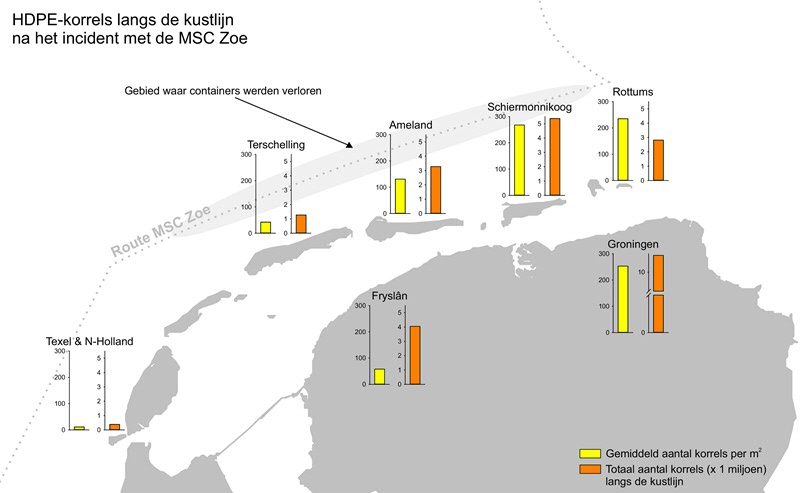Eerste onderzoeksresultaat Waddenplastic.nl
Begin januari lanceerden onderzoekers van de Rijksuniversiteit Groningen (RUG) de webapp Waddenplastic.nl om samen, met iedereen die maar wil helpen, in kaart te brengen waar en hoeveel kleine plastic korrels zijn aangespoeld nadat de MSC Zoe ca. 345 containers verloor op de Noordzee. Na ruim twee maanden laten de resultaten nu zien dat de hoogste concentraties microplastic op het Noordzeestrand van Schiermonnikoog liggen, gevolgd door de Groningse Waddenkust en de stranden van de onbewoonde Rottums. Op Schiermonnikoog wordt volgende week begonnen met het opruimen van de korrels.

Na de containerramp in de nacht van 1 op 2 januari spoelde op de stranden van Schiermonnikoog, Ameland, Terschelling en Vlieland en de Friese/Groningse kust ontzettend veel troep aan. Grotere spullen konden relatief gemakkelijk en snel opgeruimd worden, maar in het aanspoelsel (vloedmerk) zaten en zitten erg veel kleine plastic piepschuim- en HDPE-korrels. Hiervan is onduidelijk hoeveel er totaal in zee is gekomen en aangespoeld, en wat de uiteindelijke gevolgen voor natuur en milieu zijn. Het risico bestaat dat dit plastic, zeker als het verder uit elkaar valt, zich steeds verder in de voedselketen ophoopt.
300 tellingen
Op de omvang en de verspreiding van de korrels in kaart te brengen, ontwikkelden Groningse onderzoekers de webapp Waddenplastic.nl. Prof. dr. ir. Tjisse van der Heide, verbonden aan de RUG en het Koninklijk Nederlands Instituut voor Onderzoek der Zee (NIOZ): “Hiermee kon iedereen met een smartphone helpen om de plasticvervuiling in kaart te brengen door korrels te tellen in een 40x40 cm vlak. En deze telling dan samen met de locatie via de app door te geven.” Inmiddels zijn op deze manier bijna 300 ‘monsterpunten’ verzameld langs de hele noordelijke Nederlandse kustlijn. Dat wil zeggen dat er 300 tellingen zijn gedaan door waddenliefhebbers. Dit is ook te zien op de online kaart.
24 miljoen in totaal
De onderzoekers hebben nu een eerste analyse van deze verzamelde gegevens gemaakt. De resultaten tonen dat in het vloedmerk op het Noordzeestrand van Schiermonnikoog de hoogste concentratie korrels wordt gevonden – gemiddeld zo’n 268 korrels per vierkante meter. Schiermonnikoog wordt op voet gevolgd door de Groninger kust (253 korrels per m2) en de stranden van de onbewoonde eilandjes Rottumeroog en Rottumerplaat (235 korrels per m2). Doordat Groningen een veel langere kustlijn heeft dan de eilanden, is het totale aantal korrels met meer dan 12,5 miljoen hier het hoogst. Op de Schiermonnikoogse stranden liggen bijna 5,5 miljoen korrels. Van der Heide: “We schatten het totale aantal plastic korrels in het oostelijk Waddengebied op ruim 24 miljoen.”
Opruimen
Het opruimen van de kleine korrels is erg moeilijk. Op Schiermonnikoog wordt volgende week gestart met het opruimen. Dat gebeurt door het bedrijf BDS uit Harlingen in opdracht van Natuurmonumenten en de Gemeente Schiermonnikoog. Het bedrijf gebruikt daarvoor een ‘maaiklepelzuiger’. Daarmee wordt het vloedmerk, waar de meeste korrels in liggen, opgezogen. BDS zeeft daarna op het bedrijfsterrein de korrels uit het aanspoelsel om ze gescheiden te kunnen verwerken. De plastic korrels die in het zand liggen of op de kwelder zijn beland, kunnen niet met de maaiklepelzuiger worden verwijderd.

Meer nieuws
-
19 december 2025
Mariano Méndez ontvangt Argentijnse RAÍCES-prijs
-
18 december 2025
Waarom innoveren, en voor wie?
-
17 december 2025
Ben Feringa wint Feynmanprijs
